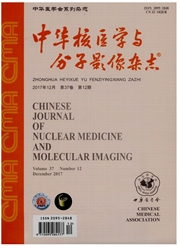

 中文摘要:
中文摘要:
目的研究^131Ⅰ-RC-160(伐普肽)对转染人生长抑素受体二型(SSTR2)的A549(A549-SSTR2)肺腺癌移植瘤的抑制作用。方法建立A549-SSTR2肺腺癌裸鼠皮下移植瘤模型,同时建立pcDNA3质粒转染组的A549(A549-pc3)肺腺癌移植瘤模型作对照,观察^131Ⅰ-RC-160、RC-160、Na^131Ⅰ对移植瘤的抑制作用,等量的生理盐水作空白对照。治疗结束后,计算抑瘤率,随后处死裸鼠,取肿瘤组织作HE染色和免疫荧光染色,观察瘤组织的病理变化。采用SPSS11.0软件对数据进行统计学处理。结果A549-SSTR2细胞致瘤组中^131Ⅰ-RC.160组和RC-160组的移植瘤生长明显受抑[抑瘤率分别为(75.1±4.2)%和(45.2±3.7)%],且^131Ⅰ-RC-160的抗肿瘤增殖效应较RC-160明显提高,差异有统计学意义(t=-6.165,P〈0.01);HE染色显示^131Ⅰ-RC-160组的肿瘤组织大部分片状坏死,残留少量瘤细胞,RC-160组肿瘤组织也可见片状坏死,但不如^131Ⅰ-RC-160组明显;免疫荧光染色显示^131Ⅰ-RC-160组和RC-160组的坏死区域荧光强度明显减弱,未坏死区域与生理盐水对照组无明显差异,可见明亮的绿色荧光。A549-pc3细胞致瘤组中,^131Ⅰ—RC-160和RC-160对瘤体有较弱的抑制效应[抑瘤率分别为(18.4±3.9)%和(15.2±3.4)%],与生理盐水组差异均无统计学意义(t值分别为-0.261和-0.302,P〉0.1);HE染色显示可见点状坏死,未见明显片状坏死;免疫荧光染色各组均未见明显的绿色荧光。Na^131Ⅰ组对转染或未转染SSTR2的移植瘤抑制作用与生理盐水组差异无统计学意义。结论将SSTR2转染至不表达SSTR2的肿瘤后,可以介导放射性核素对肿瘤进行靶向杀伤效应,提高对这类肿瘤的治疗效果,为外源性受体基因介导放射性核素靶向性内照射治疗肿瘤提供依据。
 英文摘要:
英文摘要:
Objective The radionuclide tracing technique has an important role in the targeted diagnosis and therapy in oncology. The aim of the paper was to observe the inhibition induced by ^131I-RC-160 (Vapreotide) on a somatostatin receptor subtype 2 (SSTR2) transfected A549 (A549-SSTR2) lung adenocarcinoma in nude mice. Methods The tumor model of A549 lung carcinoma transfected with SSTR2 (A549-SSTR2) was established in nude mice, with the same tumor cells transfected with plasmid pcDNA3 (A549-pc3) as control in the other side of body. The inhibition effects of ^131I-RC-160, RC-160, Na^131I and normal saline(NS) on the tumors were observed. The tumor volume was determined at the end of study and the tissue samples was HE stained and fluorescence immunocytochemistry analyzed. SPSS 11.0 was used for data analysis. Results In A549-SSTR2 tumors, the growth of the tumors was inhibited by ^131I-RC-160 and RC-160 [ (75.1 ±4.2)% and (45.2 ± 3.7)% ], and anti-proliferation of ^131I-RC-160 was stronger than that of RC-160 (t = -6. 165, P 〈 0.01 ). HE stain showed that bulk lamellar cellular necrosis occurred in up to 80% of tumor volume after ^131I-RC-160. Fluorescence immunocytochemistry proved necrosis of ^131I- RC-160 and RC-160 treated tumors. In the A549-pc3 tumor, only slight inhibition effect of ^131I-RC-160 and RC- 160 on the tumors was observed [ ( 18.4 ± 3.9 ) % and ( 15.2 ± 3.4) %, t was - 0.261, - 0.302, respectively, P 〉 0.1 ( compared with NS group) ]. Only was punctiform cellular necrosis in HE stain observed. Na^131I had no inhibition on either tumor models. Conclusion SSTR2 transfection might enhance receptor gene-mediated internal radiotherapy of human cancer.
 同期刊论文项目
同期刊论文项目
 同项目期刊论文
同项目期刊论文
 Internalization of 125I-RC-160 by and Lethal Effect of 131I-RC-160 on A549 Lung Carcinoma Cells Tran
Internalization of 125I-RC-160 by and Lethal Effect of 131I-RC-160 on A549 Lung Carcinoma Cells Tran Establishment of Cell Line Coexpressing Human Somatostatin Receptor Subtype-2 and E.coli Cytosine De
Establishment of Cell Line Coexpressing Human Somatostatin Receptor Subtype-2 and E.coli Cytosine De 期刊信息
期刊信息
